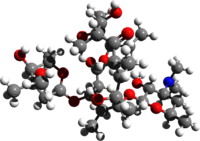Erythromycin (topical)
{{DrugProjectFormSinglePage |authorTag= Aparna Vuppala, M.B.B.S. [1]
|genericName=Erythromycin (topical)
|aOrAn=
an
|drugClass=antibacterial
|indication=acne vulgaris
|hasBlackBoxWarning=
|adverseReactions=nausea, vomiting, abdominal pain, diarrhea and anorexia
|blackBoxWarningTitle=
Title
|blackBoxWarningBody= ConditionName:
- Content
|fdaLIADAdult=
- Erythromycin Topical Solution, USP 2% is indicated for the topical treatment of acne vulgaris.
Dosage
- Erythromycin Topical Solution, USP 2% should be applied to the affected area 2 times a day (morning and evening) after the skin is thoroughly washed with warm water and soap and patted dry. Moisten the applicator or a pad with erythromycin, then rub over the affected area. Acne lesions on the face, neck, shoulder, chest and back may be treated in this manner.
- This medication should be applied with applicator top. If fingertips are used, wash hands after application. Drying and peeling may be controlled by reducing the frequency of applications.
|offLabelAdultGuideSupport=
There is limited information regarding Off-Label Guideline-Supported Use of Erythromycin (topical) in adult patients.
|offLabelAdultNoGuideSupport=
There is limited information regarding Off-Label Non–Guideline-Supported Use of Erythromycin (topical) in adult patients.
|fdaLIADPed=
There is limited information regarding FDA-Labeled Use of Erythromycin (topical) in pediatric patients.
|offLabelPedGuideSupport=
There is limited information regarding Off-Label Guideline-Supported Use of Erythromycin (topical) in pediatric patients.
|offLabelPedNoGuideSupport=
There is limited information regarding Off-Label Non–Guideline-Supported Use of Erythromycin (topical) in pediatric patients.
|contraindications=
- Erythromycin Topical Solution, USP 2% is contraindicated in those individuals who have shown hypersensitivity to any of its components.
|warnings=
- Pseudomembranous colitis has been reported with nearly all antibacterial agents, including erythromycin, and may range in severity from mild to life-threatening. Therefore, it is important to consider this diagnosis in patients who present with diarrhea subsequent to the administration of antibacterial agents.
- Treatment with antibacterial agents alters the normal flora of the colon and may permit overgrowth of clostridia. Studies indicate that a toxin produced by Clostridium difficile is one primary cause of "antibiotic-associated colitis".
- After the diagnosis of pseudomembranous colitis has been established, therapeutic measures should be initiated. Mild cases of pseudomembranous colitis usually respond to drug discontinuation alone. In moderate to severe cases, consideration should be given to management with fluids and electrolytes, protein supplementation and treatment with an antibacterial drug clinically effective against C. difficile colitis.
Precautions
- For topical use only; not for ophthalmic use. Concomitant topical acne therapy should be used with caution because a possible cumulative irritancy effect may occur, especially with the use of peeling, desquamating, or abrasive agents.
- The use of antibiotic agents may be associated with the overgrowth of antibiotic-resistant organisms. If this occurs, discontinue use and take appropriate measures.
- Avoid contact with eyes and all mucous membranes.
|clinicalTrials=
- The following additional local adverse reactions have been reported occasionally:
- peeling, dryness, itching, erythema, and oiliness. Irritation of the eyes and tenderness of the skin have been reported with topical use of erythromycin. Generalized urticarial reactions, possibly related to the use of erythromycin, which required systemic steroid therapy have been reported.
|postmarketing=
There is limited information regarding Postmarketing Experience of Erythromycin (topical) in the drug label.
|drugInteractions=
|useInPregnancyFDA=
- Teratogenic EffectsPregnancy Category B
- There was no evidence of teratogenicity or any other adverse effect on reproduction in female rats fed erythromycin base (up to 0.25% diet) prior to and during mating, during gestation and through weaning of two successive litters.
- There are, however, no adequate and well-controlled studies in pregnant women. Because animal reproduction studies are not always predictive of human response, this drug should be used in pregnancy only if clearly needed. *Erythromycin has been reported to cross the placental barrier in humans, but fetal plasma levels are generally low.
|useInPregnancyAUS=
There is no Australian Drug Evaluation Committee (ADEC) guidance on usage of Erythromycin (topical) in women who are pregnant.
|useInLaborDelivery= There is no FDA guidance on use of Erythromycin (topical) during labor and delivery.
|useInNursing=
- It is not known whether erythromycin is excreted in human milk after topical application. However, erythromycin is excreted in human milk following oral and parenteral erythromycin administration. Therefore, caution should be exercised when erythromycin is administered to a nursing woman.
|useInPed=
- Safety and effectiveness of this product in pediatric patients have not been established.
|useInGeri= There is no FDA guidance on the use of Erythromycin (topical) with respect to geriatric patients.
|useInGender= There is no FDA guidance on the use of Erythromycin (topical) with respect to specific gender populations.
|useInRace= There is no FDA guidance on the use of Erythromycin (topical) with respect to specific racial populations.
|useInRenalImpair= There is no FDA guidance on the use of Erythromycin (topical) in patients with renal impairment.
|useInHepaticImpair= There is no FDA guidance on the use of Erythromycin (topical) in patients with hepatic impairment.
|useInReproPotential= There is no FDA guidance on the use of Erythromycin (topical) in women of reproductive potentials and males.
|useInImmunocomp= There is no FDA guidance one the use of Erythromycin (topical) in patients who are immunocompromised.
|administration=
- Topical
|monitoring=
There is limited information regarding Monitoring of Erythromycin (topical) in the drug label.
|IVCompat=
There is limited information regarding IV Compatibility of Erythromycin (topical) in the drug label.
|overdose=
There is limited information regarding Chronic Overdose of Erythromycin (topical) in the drug label.
|drugBox=
|mechAction=
- The exact mechanism by which erythromycin reduces lesions of acne vulgaris is not fully known: however, the effect appears to be due in part to the antibacterial activity of the drug.
Microbiology
- Erythromycin acts by inhibition of protein synthesis in susceptible organisms by reversibly binding to 50 S ribosomal subunits, thereby inhibiting translocation of aminoacyl transfer-RNA and inhibiting polypeptide synthesis. Antagonism has been demonstrated in vitro between erythromycin, lincomycin, chloramphenicol, and clindamycin.
|structure=
- Erythromycin Topical Solution, USP 2% contains erythromycin ((3R*,4S*,5S*,6R*,7R*, 9R*,11R*, 12R*,13S*,14R*)-4-[(2,6-Dideoxy-3-C-methyl-3-O-methyl-α-L-ribo-hexopyranosyl)-oxy]-14-ethyl-7,12,13-trihydroxy-3, 5, 7, 9,11,13-hexamethyl-6-[[3,4,6-trideoxy-3-(dimethylamino)-β-D-xylo-hexopyranosyl]oxy]oxacyclotetradecane-2,10-dione), for topical dermatologic use. Erythromycin is a macrolide antibiotic produced from a strain of Saccaropolyspora erythraea (formerly Streptomyces erythreus). It is a base and readily forms salts with acids.
- Chemically, Erythromycin is C37H67NO13. It has the following structural formula:
- Erythromycin has the molecular weight of 733.94. It is a white or slightly yellow, crystalline powder and it is slightly soluble in water; soluble in alcohol, in chloroform and in ether.
- Each mL of Erythromycin Topical Solution, USP 2% contains 20 milligrams of erythromycin in a base of alcohol, USP (66.0%) and propylene glycol, USP.
|PD=
There is limited information regarding Pharmacodynamics of Erythromycin (topical) in the drug label.
|PK=
There is limited information regarding Pharmacokinetics of Erythromycin (topical) in the drug label.
|nonClinToxic=
- Carcinogenesis, Mutagenesis, Impairment of Fertility
- No animal studies have been performed to evaluate the carcinogenic and mutagenic potential or effects on fertility of topical erythromycin. However, long-term (2-year) oral studies in rats with erythromycin ethylsuccinate and erythromycin base did not provide evidence of tumorigenicity. There was no apparent effect on male or female fertility in rats fed erythromycin (base) at levels up to 0.25% of diet.
|clinicalStudies=
There is limited information regarding Clinical Studies of Erythromycin (topical) in the drug label.
|howSupplied=
- Erythromycin Topical Solution, USP 2% is supplied as follows:
- 60 mL bottle with applicator NDC 60432-671-60
- Store in a dry place at temperatures between 15 °–25 °C (59 °–77 °F) [See USP Controlled Room Temperature].
- KEEP TIGHTLY CLOSED
|fdaPatientInfo=
- Patients using Erythromycin should receive the following information and instructions:
- This medication is to be used as directed by the physician. It is for external use only. Avoid contact with the eyes, nose, mouth, and all mucous membranes.
- This medication should not be used for any disorder other than that for which it was prescribed.
- Patients should not use any other topical acne medication unless otherwise directed by their physician.
- Patients should report to their physician any signs of local adverse reactions.
|alcohol=
- Alcohol-Erythromycin (topical) interaction has not been established. Talk to your doctor about the effects of taking alcohol with this medication.
|brandNames=
|lookAlike=
|drugShortage=
}}
{{#subobject:
|Label Page=Erythromycin (topical) |Label Name=Erythromycin (topical)02.png
}}
{{#subobject:
|Label Page=Erythromycin (topical) |Label Name=Erythromycin (topical)03.png
}}


